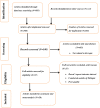Willingness to pay for Social Health Insurance and associated factors among Public Civil Servants in Ethiopia: A systematic review and meta-analysis
- PMID: 38335220
- PMCID: PMC10857707
- DOI: 10.1371/journal.pone.0293513
Willingness to pay for Social Health Insurance and associated factors among Public Civil Servants in Ethiopia: A systematic review and meta-analysis
Abstract
Background: The provision of equitable and accessible healthcare is one of the goals of universal health coverage. However, due to high out-of-pocket payments, people in the world lack sufficient health services, especially in developing countries. Thus, many low and middle-income countries introduced different prepayment mechanisms to reduce large out-of-pocket payments and overcome financial barriers to accessing health care. Though many studies were conducted on willingness to pay for social health insurance in Ethiopia, there is no aggregated data at the national level. Therefore, this systematic review and meta-analysis aimed to estimate the pooled magnitude of willingness to pay for social health insurance and its associated factors among public servants in Ethiopia.
Method: Studies conducted before June 1, 2022, were retrieved from electronic databases (PubMed/Medline, Science Direct, African Journals Online, Google Scholar, and Web of Science) as well as from Universities' digital repositories. Data were extracted using a data extraction format prepared in Microsoft Excel and the analysis was performed using STATA 16 statistical software. The quality of the included studies was assessed using the Newcastle-Ottawa Scale for cross-sectional studies. To evaluate publication bias, a funnel plot, and Egger's regression test were utilized. The study's heterogeneity was determined using Cochrane Q test statistics and the I2 test. To determine the pooled effect size, odds ratio, and 95% confidence intervals across studies, the DerSimonian and Laird random-effects model was used. Subgroup analysis was conducted by region, sample size, and publication year. The influence of a single study on the whole estimate was determined via sensitivity analysis.
Result: To estimate the pooled magnitude of willingness to pay for the Social Health insurance scheme in Ethiopia, twenty articles with a total of 8744 participants were included in the review. The pooled magnitude of willingness to pay for Social Health Insurance in Ethiopia was 49.62% (95% CI: 36.41-62.82). Monthly salary (OR = 6.52; 95% CI:3.67,11.58), having the degree and above educational status (OR = 5.52; 95%CI:4.42,7.17), large family size(OR = 3.69; 95% CI:1.10,12.36), having the difficulty of paying the bill(OR = 3.24; 95%CI: 1.51, 6.96), good quality of services(OR = 4.20; 95%CI:1.97, 8.95), having favourable attitude (OR = 5.28; 95%CI:1.45, 19.18) and awareness of social health insurance scheme (OR = 3.09;95% CI:2.12,4.48) were statistically associated with willingness to pay for Social health insurance scheme.
Conclusions: In this review, the magnitude of willingness to pay for Social Health insurance was low among public Civil servants in Ethiopia. Willingness to pay for Social Health Insurance was significantly associated with monthly salary, educational status, family size, the difficulty of paying medical bills, quality of healthcare services, awareness, and attitude towards the Social Health Insurance program. Hence, it's recommended to conduct awareness creation through on-the-job training about Social Health Insurance benefit packages and principles to improve the willingness to pay among public servants.
Copyright: © 2024 Kaso et al. This is an open access article distributed under the terms of the Creative Commons Attribution License, which permits unrestricted use, distribution, and reproduction in any medium, provided the original author and source are credited.
Conflict of interest statement
The authors have declared that no competing interests exist
Figures











Similar articles
-
Willingness to join community-based health insurance and associated factors among households in Ethiopian: a systematic review and meta-analysis.Cost Eff Resour Alloc. 2025 Apr 10;23(1):12. doi: 10.1186/s12962-025-00620-0. Cost Eff Resour Alloc. 2025. PMID: 40211299 Free PMC article. Review.
-
Willingness to pay for social health insurance in Ethiopia: A systematic review and meta-analysis.Front Public Health. 2023 Mar 22;11:1089019. doi: 10.3389/fpubh.2023.1089019. eCollection 2023. Front Public Health. 2023. PMID: 37033025 Free PMC article.
-
Towards universal health coverage: The level and determinants of enrollment in the Community-Based Health Insurance (CBHI) scheme in Ethiopia: A systematic review and meta-analysis.PLoS One. 2022 Aug 18;17(8):e0272959. doi: 10.1371/journal.pone.0272959. eCollection 2022. PLoS One. 2022. PMID: 35980888 Free PMC article.
-
Is Ethiopian community-based health insurance affordable? Willingness to pay analysis among households in South Central, Ethiopia.PLoS One. 2022 Oct 27;17(10):e0276856. doi: 10.1371/journal.pone.0276856. eCollection 2022. PLoS One. 2022. PMID: 36301951 Free PMC article.
-
Willingness to pay for social health insurance and its associated factors among public servants in Addis Ababa, Ethiopia: a cross-sectional study.BMC Health Serv Res. 2022 Jul 13;22(1):909. doi: 10.1186/s12913-022-08304-8. BMC Health Serv Res. 2022. PMID: 35831860 Free PMC article.
Cited by
-
Psychosocial determinants of the willingness to pay for social health insurance among workers at a commercial bank in Dessie, Ethiopia: a multi-setting study.Front Public Health. 2025 Jan 23;12:1403568. doi: 10.3389/fpubh.2024.1403568. eCollection 2024. Front Public Health. 2025. PMID: 39917523 Free PMC article.
References
-
- Karen A. Grépin, Bridget R. Irwin, Trakinsky BS (2020) On the Measurement of Financial Protection: An Assessment of the Usefulness of the Catastrophic Health Expenditure Indicator to Monitor Progress Towards Universal Health Coverage. Health Systems & Reform 6. - PubMed
-
- WHO, Bank W (2019) Global Monitoring Report on Financial Protection in Health 2019.
-
- Acharya A, Vellakkal S, Kalita S, Taylor F, Satija A, et al.. (2011) Do social health insurance schemes in developing country settings improve health outcomes and reduce the impoverishing effect of healthcare payments for the poorest people. A systematic review.
Publication types
MeSH terms
LinkOut - more resources
Full Text Sources

